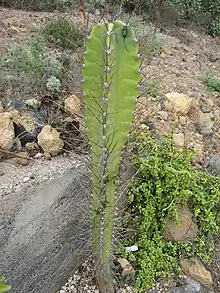| Cereus aethiops | |
|---|---|
 | |
| Scientific classification | |
| Kingdom: | Plantae |
| Clade: | Tracheophytes |
| Clade: | Angiosperms |
| Clade: | Eudicots |
| Order: | Caryophyllales |
| Family: | Cactaceae |
| Subfamily: | Cactoideae |
| Genus: | Cereus |
| Species: | C. aethiops |
| Binomial name | |
| Cereus aethiops | |
| Synonyms[2][3] | |
| |
Cereus aethiops is a species of cactus found from Uruguay to Argentina.[3]
Description
Cereus aethiops grows shrubby, is rarely branched and reaches heights of growth of up to 2 meters. The cylindrical, dark bluish to dark green shoots are upright, occasionally prostrate and have a diameter of 2 to 4 centimeters. There are seven to eight ribs that are divided into humps. The areoles on it are often almost black. The two to four black central spines are up to 2 centimeters long. The nine to twelve radial spines are gray with a darker tip or black. They reach lengths of up to 10 millimeters.
The white to light pink flowers are up to 20 centimeters long. The egg-shaped, red fruits are up to 6 centimeters long.
 Fruit
Fruit Plant growing in the wild climbing on Geoffroea decorticans at Colonia Cilavert, Las Grutas, Río Negro province, Patagonia, Argentina
Plant growing in the wild climbing on Geoffroea decorticans at Colonia Cilavert, Las Grutas, Río Negro province, Patagonia, Argentina
Distribution
Cereus aethiops is distributed in the foothills of the Andes in northern and central Argentina.
Taxonomy
The first description by Adrian Hardy Haworth was published in 1830.[4] A nomenclatural synonym is Piptanthocereus aethiops (Haw.) F.Ritter (1980).
The IUCN Red List of Threatened Species lists the species as Least Concern (LC)[1]
References
- 1 2 "The IUCN Red List of Threatened Species". IUCN Red List of Threatened Species. 2010-09-20. Retrieved 2023-08-13.
- ↑ "Cereus aethiops Haw". Plants of the World Online. Royal Botanic Gardens, Kew. Retrieved 2021-09-25.
- 1 2 "Cereus aethiops Haw.". Tropicos. Missouri Botanical Garden. Retrieved 2021-09-25.
- ↑ The Philosophical Magazine: Or Annals of Chemistry, Mathematics, Astronomy, Natural History and General Science. Richard Taylor. 1830. p. 109. Retrieved 2023-08-13.
External links
 Media related to Cereus aethiops at Wikimedia Commons
Media related to Cereus aethiops at Wikimedia Commons Data related to Cereus aethiops at Wikispecies
Data related to Cereus aethiops at Wikispecies
